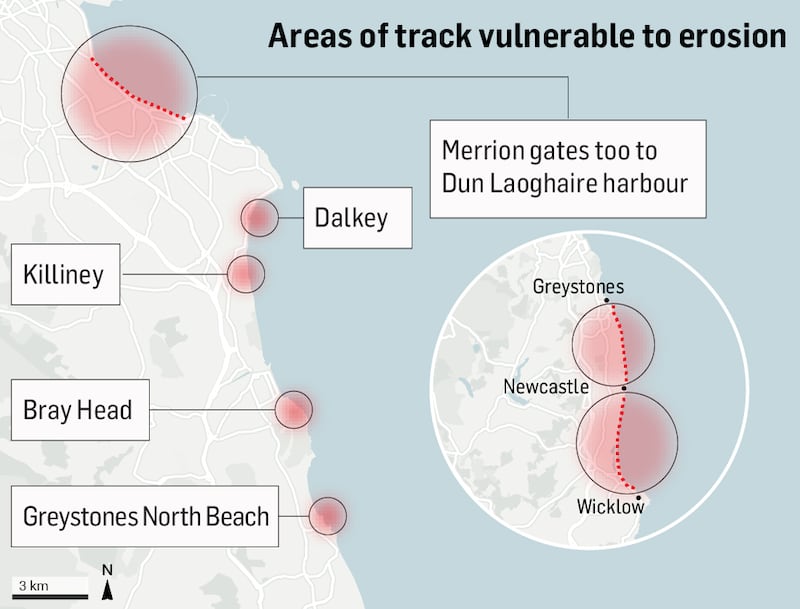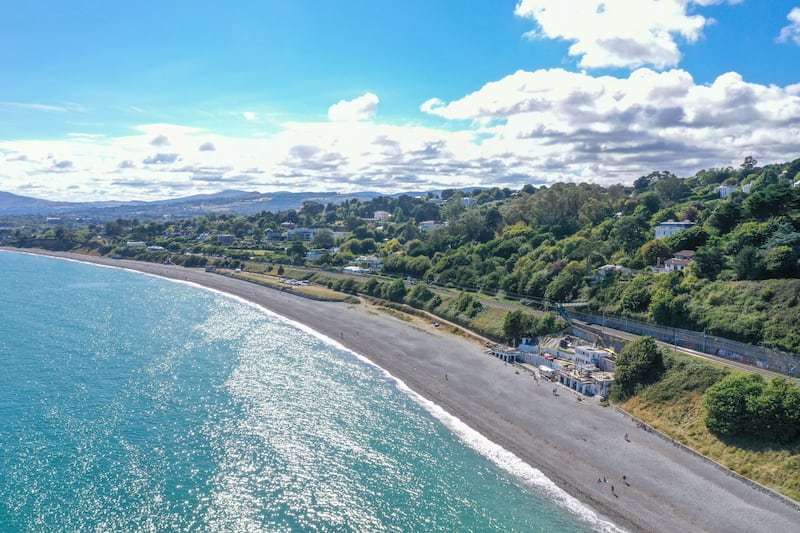The coastal train journey from Dublin to Rosslare in south Wexford is undeniably beautiful, with sweeping views over Dublin Bay and the Wicklow Mountains, but its aesthetic assets are also its vulnerabilities, as the scenic line edges ever closer to the sea.
The rail line, which carries Dart and mainline services, is now the subject of Northern Europe’s largest coastal protection programme, the €230 million East Coast Railway Infrastructure Protection Projects, a series of interventions along sections of line most at risk from erosion and flooding.
“This is a body of work that involves looking at sites that, from an environmental point of view, effect the railway infrastructure,” Aidan Bermingham Irish Rail infrastructure programme manager says.
“We’re looking at a stretch from the Merrion Gates to Dún Laoghaire Harbour; Dalkey and Killiney; Bray Head and Greystones North Beach. Then we’ve split up the area South of Greystones into two areas — Greystones to Newcastle and then Newcastle down to Wicklow Harbour,” he says. “We are not looking at the beaches in between, where there isn’t an impact on the rail line, it’s the likes of Killiney where we are right on the beach.”

The type of protection used will vary from site to site Mr Bermingham says, depending on environmental considerations and the nature of the impact on the line.
In Killiney where “climate change and increased rainfall has eroded the facade of the embankment” work is likely to include “soil nailing” where large nails are put into the ground “to anchor the rock and clamp it back to hold the bank in place”.
Towards Dalkey there is more severe erosion. “Our initial feasibility studies have identified that offshore breakwaters are required to dissipate the energy. By dissipating the energy hitting the coast that will in turn reduce the impact of the erosion of the sea.”
From the Merrion Gates to Dún Laoghaire the main problem is wave overtopping, where the sea floods the line, sometimes resulting in the suspension of services. Offshore solutions are also likely to be considered along this stretch. In addition “beach nourishment” is likely to be implemented in places along the full project area.

“Beach nourishment is selecting and material you put on the beach that the sea can’t easily take away. You find a matching material with what’s on the beach, stones or sand, and you increase the width of your beach and that will give you resistance.”
This is not the first time the line, which opened in the 1850s, has been subject to major interventions to protect it from the sea, he says.
“The railway is 150- to 170-years-old and always had challenges. At Bray Head the tunnels have been moved in because the trellises have been taken away in storms. South of Greystones in the 1970s the railway line was moved in 30 or 40 meters due to the erosion rates.”
However, he says extreme weather events effecting the line have increased significan
tly in recent decades, worsening the impact of erosion or flooding of the line and requiring a more holistic, comprehensive approach.

“Around 2004 we had a track washout south of Greystones, then Storm Emma removed some rock armour in the coastal defences. We’ve had increased rainfall in Bray Head coming down through the track and leaching through underneath the track. It’s a combination, depending on the wave and the tide and the rainfall effect, and everything that’s coming at us. You get a good bit of damage which has to be fixed.”
Most of the work involved will be “off-track” he says, and where work is required on the line, Irish Rail will endeavour to keep disruption to a minimum. Any disruption would he said be minor compared with the effects of climate change on the line.
“When you have a track washout, the track is left sitting in the air obviously you have to stop services. But even the more simple ones like when you have a high tide, a storm event, and an easterly wind with significant overtopping on the line you can have disturbance in service for an hour or more.”














